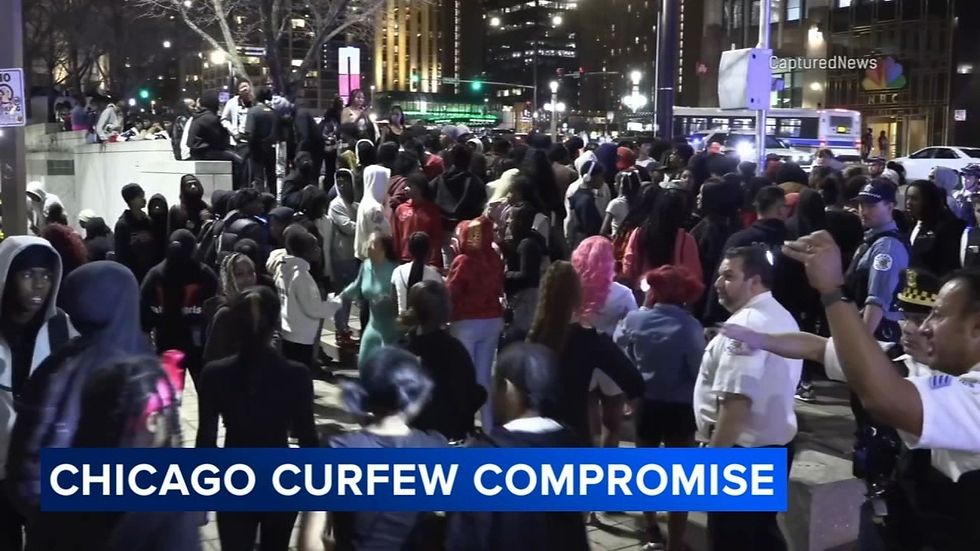Youth Don’t Need More Curfews—They Need More Choices
- Marcus Flenaugh

- Apr 15
- 4 min read

Let's Be Clear—This Isn’t Just About “Teen Takeovers.” It’s About the Grown-Ups Who Took Away Their Options.
There has been a lot of noise lately in Chicago about teens "taking over" downtown. Curfews. Geofencing. Increased Policing. Before we rush to criticize young people for showing up in public spaces, let’s take a hard look at the public investments that no longer show up for them.
Let's pause the moral panic for a moment and ask a deeper question:
What are we actually offering our young people instead?
It’s about choices. If we want to see different behavior, we have to offer different options. I’m from the Roseland/Washington Heights communities on the Far South Side. I spent some of my formative teen years living in West Garfield Park. I know what happens when a city forgets how to care. I’ve watched after-school programs disappear. I’ve seen parks rot while budgets grew elsewhere. Community centers? Shut down. And instead of rebuilding what held us together—we built more barriers. More “enforcement.” Fewer opportunities.
But let me be fair: Chicago is trying. According to the recently published Youth Impact Report, In 2024, over 100,000 youth were served through jobs, enrichment, and community programs. One Summer Chicago employed nearly 28,000 teens. After School Matters reached 19,000. My CHI. My Future. hosted over 150 youth-led events.
That’s good. But here’s the hard part:
It’s not enough.
Chicago is home to nearly half a million young people ages 10 to 24. Four out of five are still waiting. Or worse—completely left out.
And for Black teens? The disparity is even deeper. UIC’s Great Cities Institute reports that Black youth in Chicago face joblessness at rates up to 40% higher than their peers in wealthier areas like Schaumburg. The system isn’t broken. It’s underbuilt.
Let me speak this truth for the ones in tailored suits— the ones who grew up on blacktop dreams, who knew the rhythm of a basketball on cracked pavement. Or those who coasted down side streets before bike lanes had brand consultants.
The system isn’t broken. It was born incomplete.
And our young people? They feel that absence like a draft through a boarded-up gym.
They know first hand what wasn’t finished. What was never offered and never seen to fruition. What was quietly taken away. You read about them in bold fonts and biased framing.
But in real life? There are youth demanding partnership—not pity—and building what we refused to. They’re not asking for handouts. They’re asking for a seat at the table they’ve been locked out of.
So let’s be clear:
Youth aren’t “taking over” the city.
They’re navigating a city that too often hasn’t made room for them.
And now we’re mad that they’re visible? They are showing up on "your" doorsteps and in "your" parks.
We should be mad that we left them with so little to choose from.
Instead of curfews, here’s what I feel adults can actually do:
✅ Mentor a teen. You don’t need a title. You don't have to be perfect. You just need to show up—and be consistent.
✅ Open your doors. If you run a church, barbershop, café, gym, or small business, make space for youth events, open mics, workshops, or just a safe place to be in the community.
But here’s the key: If you open the space—invite service providers to come to them.
Too often, service providers operate like youth should come to them—as if access is just a matter of interest. But let’s be honest: not every young person feels safe or welcome walking into an unfamiliar office across town. If you are geniune in reaching them, go where they already are.
✅ Collaborate across programs. We don’t need ten disconnected orgs reinventing the wheel. We need alignment. If a space opens for teens, wrap it with coordinated mental health support, job training, arts programming, college access, mentorship. Don’t operate in silos—operate like a system that cares.
✅ Stay present after 5pm. Teens don’t vanish after business hours. That’s when they need connection most—when school’s out, when streets get loud, when homes might feel unstable. Structure your programming with their lives in mind, not your staff’s convenience.
✅ Hire young people. Offer internships, paid projects, shadowing. Make work experience flexible and real. Give them opportunity to learn from you.
✅ Support youth-serving orgs. Donate, volunteer, spread the word. Groups are are already putting in the work. Back them.
✅ Push for equity in city and state budgets. Be loud. Demand transparency. Ask how youth dollars are being allocated—and to whom.
✅ Ask your employer or company to sponsor a youth program. Corporations love the optics—so make them put their dollars where their mission statement is. Community investment isn’t charity. It’s responsibility.
✅ Host a neighborhood event. Bring people together. Cook out. Set up a mic. Build community that doesn’t need a permit to feel safe.
✅ Quadruple after-school and summer programs. Right now, four young people wait for every one enrolled. That is not acceptable.
✅ Include youth in planning. Stop building programs for them. Start building with them. Give them a seat at the table—and listen when they speak.
✅ Make transit safe and accessible. Because getting to a program shouldn’t be the hardest part of going.
Roseland and Washington Heights taught me what community used to feel like. Porches. Basketball. Elders who knew your name and watched your back. Being home when those turned on. That wasn’t nostalgia. That was infrastructure. That was safety. That was belonging. And our youth still deserve that. So let’s stop treating their presence as a threat—and start seeing it as a call to action.
Young people aren’t the problem.
Disinvestment is.




Well said! We need more people working and standing up for youth programs.